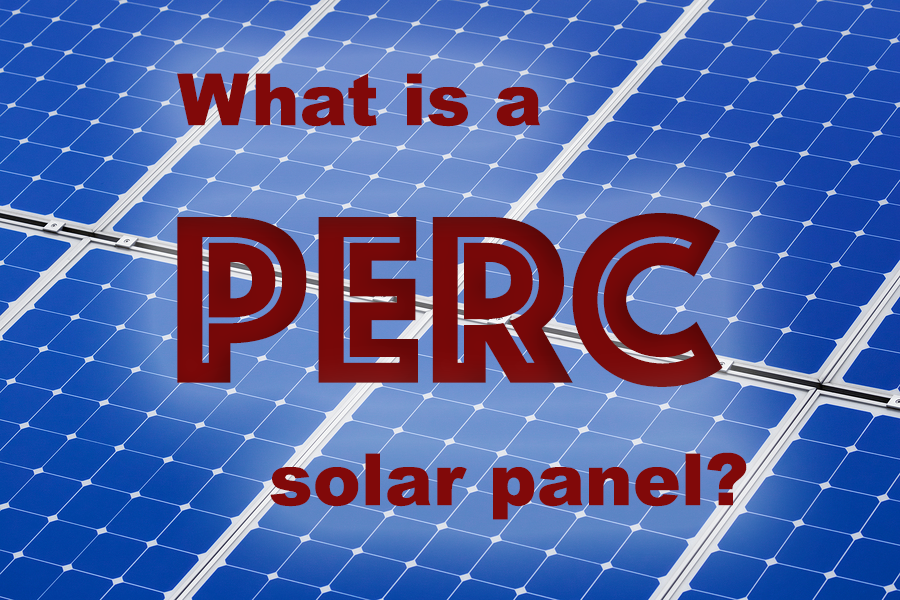
34 years after it was invented ‘PERC’ is now a big deal in solar panel technology. But what the hell is it?
Update 16th April 2019: Many PERC panels have suffered from LeTID deterioration problems since this article was written. This article here goes into the problem and this article on the MC Electrical blog covers it in detail and gives information on which PERC panels are resistant to LeTID.
Solar panel manufacturers crave efficiency. I’m not talking about the labour efficiencies they receive from building new production lines that are robot-heavy and people-light, although they like those too.
The efficiency I am referring to is turning light into electricity. The higher a solar panel’s efficiency, the more watts of power you can get from the same amount of silicon. As solar panels are sold by the watt, mo’ watts means mo’ money.
This is why the holy grail of the PV industry is increased solar cell efficiency.
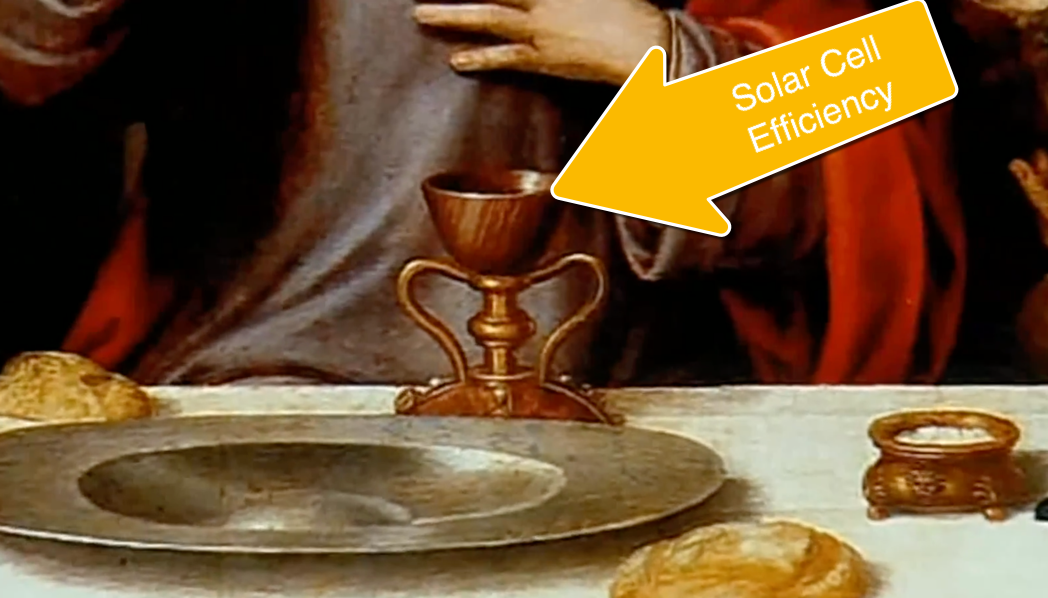
And you thought I’d put a Monty Python video here. Or at least an Indiana Jones clip.
One of the most cost effective methods of improving efficiency that has caught on this decade is PERC. While it’s not quite a holy grail, it has to at least count as a holy beer stein and is definitely better than a mere holy shot glass.
PERC stands for Passivated Emitter and Rear Cell1. It improves efficiency by allowing electrons to flow more freely and also by increasing the reflectiveness of the back of solar cells. I’ll explain how it works later in the article. (Provided I actually understand it myself by the time I get to that point.)
Currently, around one quarter of new solar panels are PERC and the figure may reach 50% in 2020. The reason it has become popular is because it adds little to the cost of solar panels while increasing their efficiency by around one whole percentage point. That is, it can turn a boring old 16% efficient panel into an exciting 17% efficient one.2
In this article I will explain, or possibly fail to explain, just what PERC is, why the majority of panels may be PERC in the future, and if you should give a damn whether your panels are PERC or not.
Spoiler Alert: Frankly my dear, you shouldn’t give a damn.
PERC Is An Australian Invention
PERC was invented in Australia because we’re so awesome. Or at least that subset of us who were working on solar cell technology in the University of New South Wales in the 80s, many of whom came from overseas, are awesome. But that’s okay. I’m sure it is a kind of contagious, nationalistic awesomeness that has since spread to us all.
Sure, some Americans deserve a quantum of credit for producing the first actual paper on the topic, but that’s okay, we can just make them honorary Australians in much the same way we claim Russell Crowe is Australian, right up until the point he starts pegging his phone at people,
And how we used to say Mel Gibson was Australian until he went freaking nuts.

Despite once playing a smurf, Mel Gibson would later go on to blame everything on “the Blues”.
How PERC Works
If you want to read an in depth and detailed description of how PERC solar cells work then I recommend this article by Australia’s master of green technology, Martain A. Green.
If you want a simplified and possibly laughably botched explanation, then don’t stop reading now.
How Solar Cells Work
Most solar panels use P-type cells while some high efficiency and higher cost panels use N-type cells. You can read about the difference between the two in P and N’s excellent article here.
When light hits silicon atoms in a solar cell it can knock electrons free. These electrons are negatively charged and the atoms that lose them become positively charged. Since opposites attract the two want to recombine to make themselves whole again. But solar cells are made so electrons gather on one side and can’t reach the positive atoms on the other side.
In P-type cells, the most common sort, the base of the cell is positive and the top is negative. The top layer of silicon where the electrons gather is called the emitter. Since the negative electrons at the top are blocked from taking the shortest path to the positive atoms below, they pass through a fine grid of wires on the surface of the cell and keep traveling until they arrive at the bottom of the solar cell. As they travel on their merry way we can exploit them to provide power to run lights, laptops, solar inverters, and potentially many other things.
But if electrons and atoms recombine under the metal contacts on either the surface or rear of the cell, it reduces the voltage and limits the cell’s output. This effect can be reduced by passivation, which is what the first letter in PERC stands for.
P is For Passivation
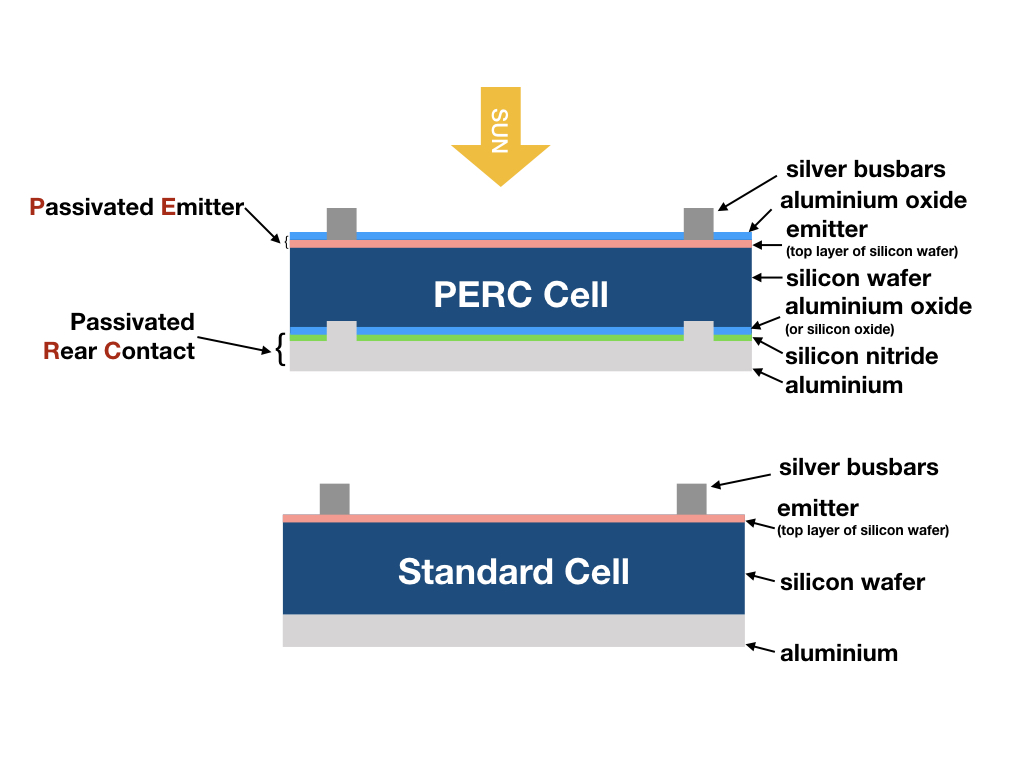
The difference between a PERC solar cell and a regular one is the passivation on the top and bottom. (Note to nitpickers: this is a simplified diagram)
Passivation involves creating a layer of oxidized material. The layer under the grid of wires on the surface of the cell is usually aluminium oxide. On the rear of the cell it is either aluminium oxide or silicon oxide, followed by a layer of silicon nitride. And that’s all the four letters in PERC — Passivated Emitter and Rear Cell.
On the rear of the cell, the metal contacts still need to touch the silicon of the cell, so a “laser” is used to cut holes in the passivation layer on the back for the metal contacts to enter.
Passivation Makes Bottoms Shine
Helping electrons flow is not the only advantage of passivation. It also increases the amount of light reflected from the bottom of the cell. This is useful because if light missed hitting a silicon atom and knocking an electron free on its way in, reflection will give a second chance on the way out.
Almost all solar cells have a reflective layer on the bottom3 which is normally aluminium. But because the refractive index of silicon is higher than glass4 the resulting reflectivity of around 89% isn’t as high as a normal aluminium backed glass mirror. But placing the passivated layer with a lower refractive index between the silicon and the aluminium can increase reflectivity close to the maximum possible of 98%. This gives a slight boost to the panel’s efficiency.
Reflecting more light and reducing the amount absorbed by the back of the panel makes it a little bit cooler and this also results in a small increase in efficiency.
Light Induced Degradation Can Be Worse Than Average
Light Induced Degradation, or LID, reduces the efficiency of P-type solar panels by around 3% after their first few days in the sun. To be clear, this is 3% and not 3 percentage points, which would be far worse5. In PERC panels LID can be worse than average, but it’s not nearly enough to cancel out the benefits of PERC.
LID can be avoided by using N-type solar cells, but as they are more expensive than conventional P-type cells, costs will have to come down before there is a major shift to them.
We’re In For A World Of PERC
PERC solar panels first appeared around 2012 but it took manufacturers several years to refine the process and bring down costs. Over the past year or two PERC panels have really taken off and perhaps one quarter of new panels produced are PERC. This may reach 50% in 2020.
While manufacturers have become pretty good at making PERC panels, it is still possible there is room for improvement and we may see further cost decreases and efficiency improvements making PERC even more popular. But I wouldn’t expect huge improvements. After all, even though the process involves strange words and unseen forces, it’s not magic.
It Doesn’t Matter Whether Or Not Your Panels Are PERC
While PERC makes panels more efficient and is becoming more popular, you don’t need to worry about whether or not your panels are PERC. So if a salesperson tries to convince you you have to have PERC you can tell her to go jump. Or maybe just smile and nod while ignoring her if you are feeling polite.
There are important things you do need to worry about when it comes to selecting solar panels and the main ones are:
- Are the panels tier one or made by a manufacturer that is known to produce reliable panels?
- How long are the panel’s warranties?
- Do the panels have special features such as panel string optimization or the ability to bypass individual cells that are soiled, as many of SunPower’s panels can?
The efficiency of panels is only important if you have a limited amount of roof space or you want to keep some space free for future use. Just looking at a panel’s efficiency is sufficient if you are looking for high efficiency ones. The panel you choose may well turn out to be PERC, but there is no need to actively seek it out.
Footnotes
- PERC also sometimes gets called Passivated Emitter and Rear Contact. ↩
- That might not sound like much, but it can mean the difference between life and death if a lunatic ever points a gun at you and demands a 17% efficient panel. ↩
- Bifacial panels are an exception and don’t have a reflective layer on their cells so they can make use of light coming from both sides of the panel. ↩
- Glass contains silicon, but is not almost pure silicon like the wafers solar cells are made from. ↩
- A 17% efficient panel that has its efficiency decline by 3% will have its efficiency reduced by half a percentage point, down to 16.5%. ↩

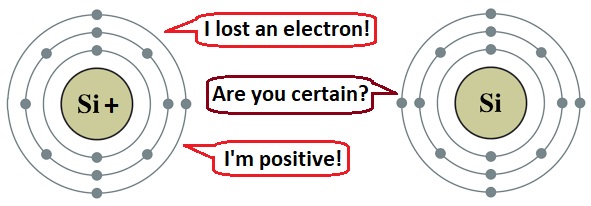
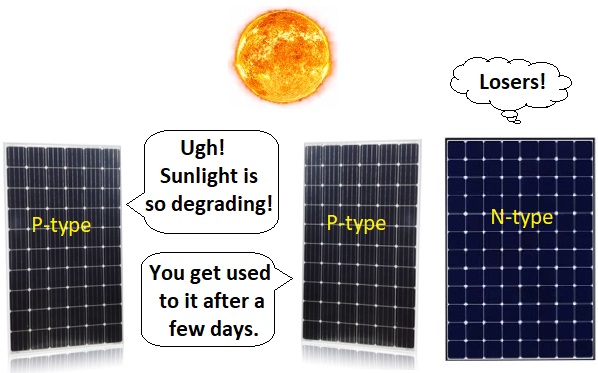
 RSS - Posts
RSS - Posts



Well written Ronald, its hard to make a technical topic seem interesting to the general market. We have been building PERC products since 2013, its a fantastic product to work and has enormous potential to provide real benefits to the end consumer once you get the recipe right. Our standard PERC products are 285W Poly and 310W Mono.
For a slightly more techy overview on the benefits of PERC you can check out http://www.winaico.com/fileadmin/redaktion/downloads/Broschueren_2016/SWP1601-01_EN__maximising_energy_production_potential_with_PERC_technology.pdf
Hi – I’d like an evaluation of t e hellosolar enphase battery – regards paul
Hi Paul.
I wrote about the Enphase AC battery here:
https://www.solarquotes.com.au/blog/enphase-batteries-are-impressive-but-very-unlikely-to-save-you-money/
One thing that has changed since I wrote that is the pricing has become more competitive.
Probably the most important detail to note is it’s a fairly low power battery that takes about 4.4 hours to fully discharge.
Hi,
I have just had a quote from MC electrical and they mentioned problems with PERC cells :-https://mcelectrical.com.au/blog/big-problems-with-mono-perc-solar-panels-technology/
Is this just a ‘scare tactic’ or should I avoid PERC cells? The technical details are way too hard for me to understand and I would love to hear your take on this,
thanks,
Carol
Hi Carol
Deterioration in PERC cells is a real concern. If you get a PERC panel from a manufacturer that hasn’t taken steps to minimize the problem you are running the risk of poor performance in the future. You can get PERC panels that have done well in tests such as QCELLS but unfortunately there simply isn’t information available for most panels. The easiest solution if you are concerned is to simply use panels that aren’t PERC. MC Electrical do excellent work, so if you get a system from them you can be extremely confident it will be highly reliable.
Hi Ronald,
in the other two quotes I got one was using Canadian solar panels which are recommended on this site but are quoted in the MC Electrical list of panels as using ‘ripped off’ data. Does this mean they should be removed from the list of approved panels ? Also if this PERC issue is of concern shouldn’t there be a warning about it on this site as there are many panels from the suppliers listed that use this technology? The other quote I got was using Suntech Mono panels which have PERC but this wasn’t mentioned in the quote until I asked the installer after talking to the MC electrical guy. I would not have known to ask if I hadn’t read the MC article!
thanks,
Carol
Degradation of PERC panels is a concern, so I will look into it in detail, discuss what I find with Finn (my boss), and I will write an article on what we conclude. Hopefully it won’t take me too long.
This says it all
https://mcelectrical.com.au/blog/big-problems-with-mono-perc-solar-panels-technology/
Hi, I notice there hasn’t been a comment since Feb 19 about this Letid degradation and am just about to install P19 sunpower panels on my roof in 6 weeks and would really like to know if these panels will suffer from this issue?
Thanks
Sunpower says they use high quality solar cells that don’t suffer from LeTID degradation and have submitted their P19 panels for independent testing, which is a good sign, but I can’t find the results of this testing online so maybe it’s not compete yet.
Just an update I received from someone at Sunpower:
A couple of points that not many know: 1. The technology behind the P19 was developed by a company called Cogenra. It was developed for the space program. Sunpower liked it so much they bought Cogenra back in 2016. This is very sound technology and SunPower uses the same licensed laminate from the E and X in the P.
2. The testing we have done over the last 4 months show little LiTd effect. We suspect testing done on LiTd was on cheap mono PERC panels. The P series in the field in Aus have been deployed for over a year and no issues so far.
Hi All, I am thinking of installing solar Pannels. Would someone please suggest me what I need to look and which are the best one. I have received quote for Cheetha HC 60M-V 315-335 watt Mono PREC half cell module and Suntech HyPro STP310S-20/Wfw pannels. Also can I also get suggestion about inverter I have been offered Solax X1-5.0-T and Growatt 5000TL-X inverters. Which would be good for best performance and for long term.
Thank you.
Hello Vijay
Cheetah panels are made by Jinko Solar. They are not expensive, but they are among the panels we recommend. Suntech panels are as well. You can see which panels and inverters we recommend in our Solar 101 Guide:
https://www.solarquotes.com.au/solar101.html
Solax is a lower cost inverter we can recommend. Growatt is the lowest cost inverter commonly sold in Australia. Hopefully it is good value for money, but you can’t expect the reliability you’d get from a high end inverter.
Hi Ronald,
Thank you for the reply and letting me know about the product I mentioned. Would you please suggest me what I need to look in Patnnels and inverter. As I am not sure of what to considered while installing solar so I am seeking an experience person advise. Thank you for your time.
Hello again.
The Solar 101 Guide I provided a link to has graphics that show the panels and inverters we recommend and know are value for money and well supported in Australia. If you want us to send you quotes from installers we know do good work you can go to our homepage:
https://www.solarquotes.com.au/
And enter your postcode in the space at the top right and answer the questions that come up as best you can. The quotes you receive won’t be from the cheapest installers around but they will all do good quality work.
Hi Ronald,
Thank you for the reply. Yes I had submitted my details and now waiting for details and quotes.
Possibly the most shitty article I have ever read!! Get to the point and stop tryig to be funny. Use a font that is easy to read. You’re trying too hard!
Well, at least I’m not responsible for the font.
Does the blue zinc shown in the picture have any efficiency rating?
Umm… 11?
Actually, I’m not sure what you’re referring to. If you mean Mel Gibson’s face, I’m afraid it’s no longer as efficient at selling movies as it used to be.